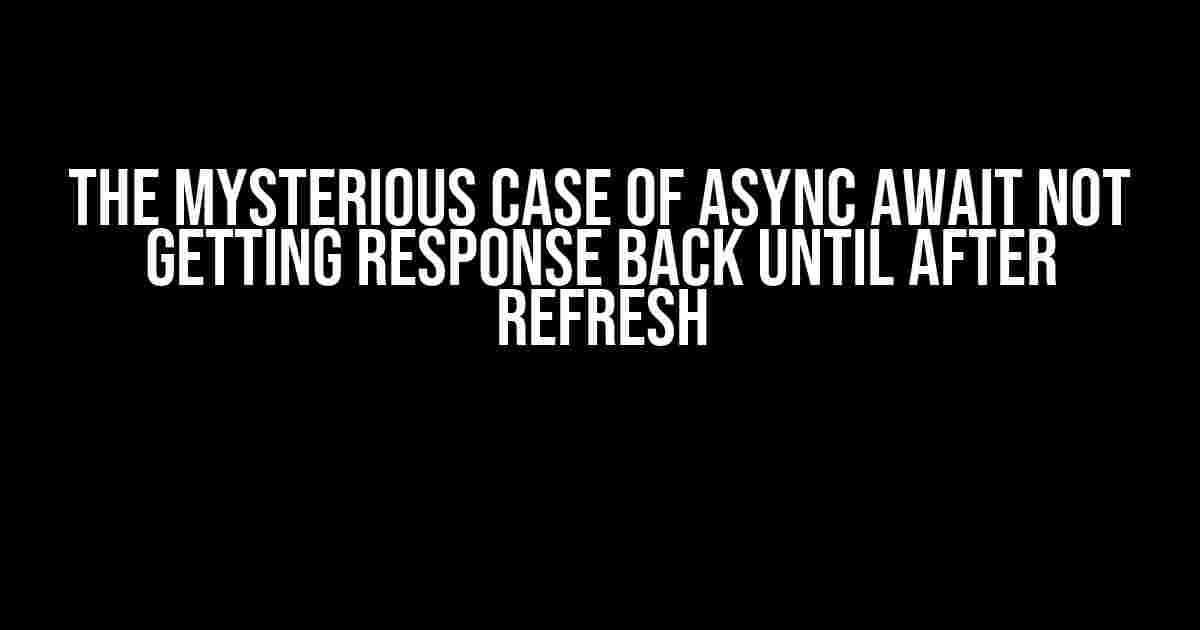Introduction
If you’re reading this article, chances are you’ve stumbled upon the frustrating issue of async await not returning a response until after you refresh the page. You’re not alone! This problem has been driving developers crazy for years, and it’s time to get to the bottom of it.
What is Async Await?
Before we dive into the solution, let’s quickly cover what async await is and how it’s supposed to work.
async function getResult() {
try {
const response = await fetch('https://api.example.com/data');
const data = await response.json();
console.log(data);
} catch (error) {
console.error(error);
}
}In the above example, we’re using async await to fetch data from an API. The `fetch` function returns a promise, which is then resolved using `await`. Once the promise is resolved, we log the data to the console.
The Problem: No Response Until Refresh
So, why is it that sometimes async await doesn’t return a response until after you refresh the page? There are several reasons for this, but don’t worry, we’ll tackle each one step by step.
Reason 1: Incorrect Implementation
The most common reason for async await not working as expected is incorrect implementation. Make sure you’re using the `async` keyword correctly and that you’re not mixing async and sync code.
function getResult() {
// Incorrect implementation
fetch('https://api.example.com/data')
.then(response => response.json())
.then(data => console.log(data));
}In the above example, we’re using `fetch` without the `async` keyword. This will not work as expected because `fetch` returns a promise, and we’re not using `await` to resolve it.
Reason 2: Async Await Not Being Used Correctly
Another common mistake is not using async await correctly. Remember that `await` can only be used inside an async function.
async function getResult() {
// Correct implementation
const response = await fetch('https://api.example.com/data');
const data = await response.json();
console.log(data);
}In the above example, we’re using `async` and `await` correctly. We declare the function as async, and then use `await` to resolve the promise returned by `fetch`.
Reason 3: CORS Issues
CORS (Cross-Origin Resource Sharing) issues can also cause async await to not return a response until after refresh. This occurs when you’re making a request to a different origin (domain, protocol, or port) than your current page.
To fix CORS issues, you can either:
- Use a proxy server to make the request
- Use the `mode: ‘cors’` option in your fetch request
- Use a CORS-enabled API
fetch('https://api.example.com/data', {
mode: 'cors'
})
.then(response => response.json())
.then(data => console.log(data));Reason 4: Server-Side Issues
Sometimes, the issue lies on the server-side. Make sure that your API is returning the correct data and that there are no errors on the server-side.
You can check the server-side logs to see if there are any errors or issues. You can also use tools like Postman or cURL to test your API and see if it’s working correctly.
Solutions
Now that we’ve covered the reasons why async await might not be returning a response until after refresh, let’s look at some solutions.
Solution 1: Use Async Await Correctly
The first solution is to use async await correctly. Make sure you’re declaring your function as async and using `await` to resolve promises.
async function getResult() {
try {
const response = await fetch('https://api.example.com/data');
const data = await response.json();
console.log(data);
} catch (error) {
console.error(error);
}
}Solution 2: Use .then() Instead of Async Await
Another solution is to use `.then()` instead of async await. This can be useful if you’re having trouble with async await.
fetch('https://api.example.com/data')
.then(response => response.json())
.then(data => console.log(data))
.catch(error => console.error(error));Solution 3: Use a Library Like Axios
Axios is a popular library that provides a simple way to make HTTP requests. It can be used as an alternative to fetch, and it often provides more detailed error messages.
import axios from 'axios';
axios.get('https://api.example.com/data')
.then(response => {
console.log(response.data);
})
.catch(error => {
console.error(error);
});Conclusion
In conclusion, async await not returning a response until after refresh is a frustrating issue that can be caused by several factors. By checking your implementation, using async await correctly, handling CORS issues, and troubleshooting server-side issues, you should be able to fix the problem and get your code working as expected.
Remember to always check your console logs for errors, and use tools like Postman or cURL to test your API. With patience and persistence, you’ll be able to overcome this issue and write asynchronous code that works like a charm.
| Reason | Solution |
|---|---|
| Incorrect Implementation | Use async await correctly |
| Async Await Not Being Used Correctly | Declare function as async and use await |
| CORS Issues | Use a proxy server, mode: ‘cors’, or a CORS-enabled API |
| Server-Side Issues | Check server-side logs and test API using Postman or cURL |
If you’re still having trouble, feel free to share your code and we’ll do our best to help you out!
FAQs
-
What is async await?
Async await is a way to write asynchronous code that’s easier to read and maintain. It allows you to write code that looks synchronous but is actually asynchronous.
-
Why is my async await code not working?
There could be several reasons why your async await code is not working. Check your implementation, make sure you’re using async await correctly, and handle CORS issues.
-
How do I fix CORS issues?
You can fix CORS issues by using a proxy server, setting the mode to ‘cors’, or using a CORS-enabled API.
-
What is Axios?
Axios is a popular library that provides a simple way to make HTTP requests. It’s often used as an alternative to fetch.
Here are 5 Questions and Answers about “Async await not getting response back until after refresh” in HTML format with a creative voice and tone:
Frequently Asked Question
Get the lowdown on async await and response refreshes!
Why am I not getting a response back until after I refresh the page?
This might be because your async function isn’t properly awaited. Make sure you’re using the `await` keyword when calling your async function, and that the function is properly marked as `async`. If you’re using a library or framework, check its documentation for specific guidance on handling async responses.
Is it possible that my async function is not returning anything?
You bet! If your async function isn’t returning anything, you won’t get a response back. Check that your function is properly returning a value, and that you’re handling any potential errors that might prevent the function from completing.
Could my browser be caching the response, causing the delay?
That’s a great question! Yes, browser caching can definitely cause issues with async responses. Try adding cache-control headers to your response to prevent caching, or use a cache-busting technique like adding a timestamp to your request.
Is there a way to debug my async function to see what’s going on?
Absolutely! You can use console logging or a debugger to step through your async function and see what’s happening. Add some logging to your function to see when it’s called, what values are being returned, and any errors that might be occurring.
What if I’m using a third-party library that’s causing the issue?
That can be tough! If you suspect a third-party library is causing the issue, try debugging the library’s code to see what’s going on. You can also check the library’s documentation and issue tracker to see if others have reported similar problems.


